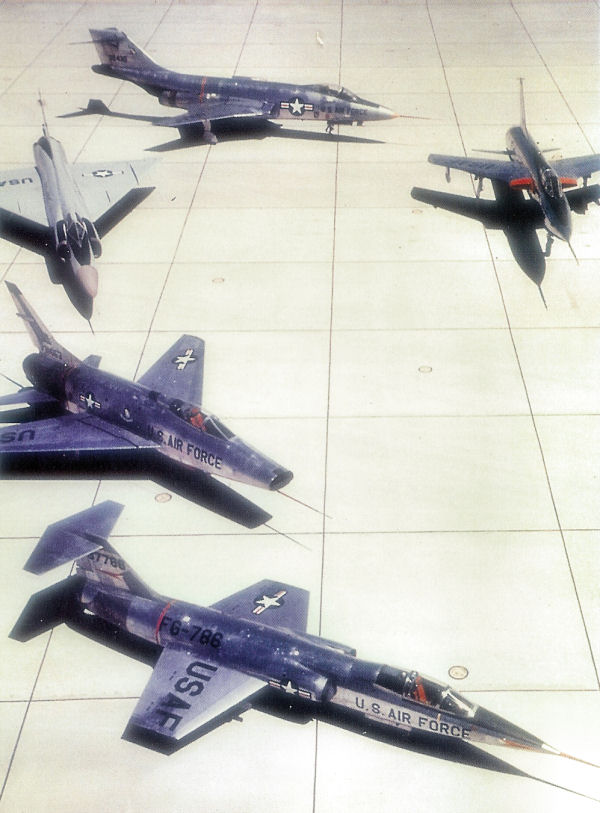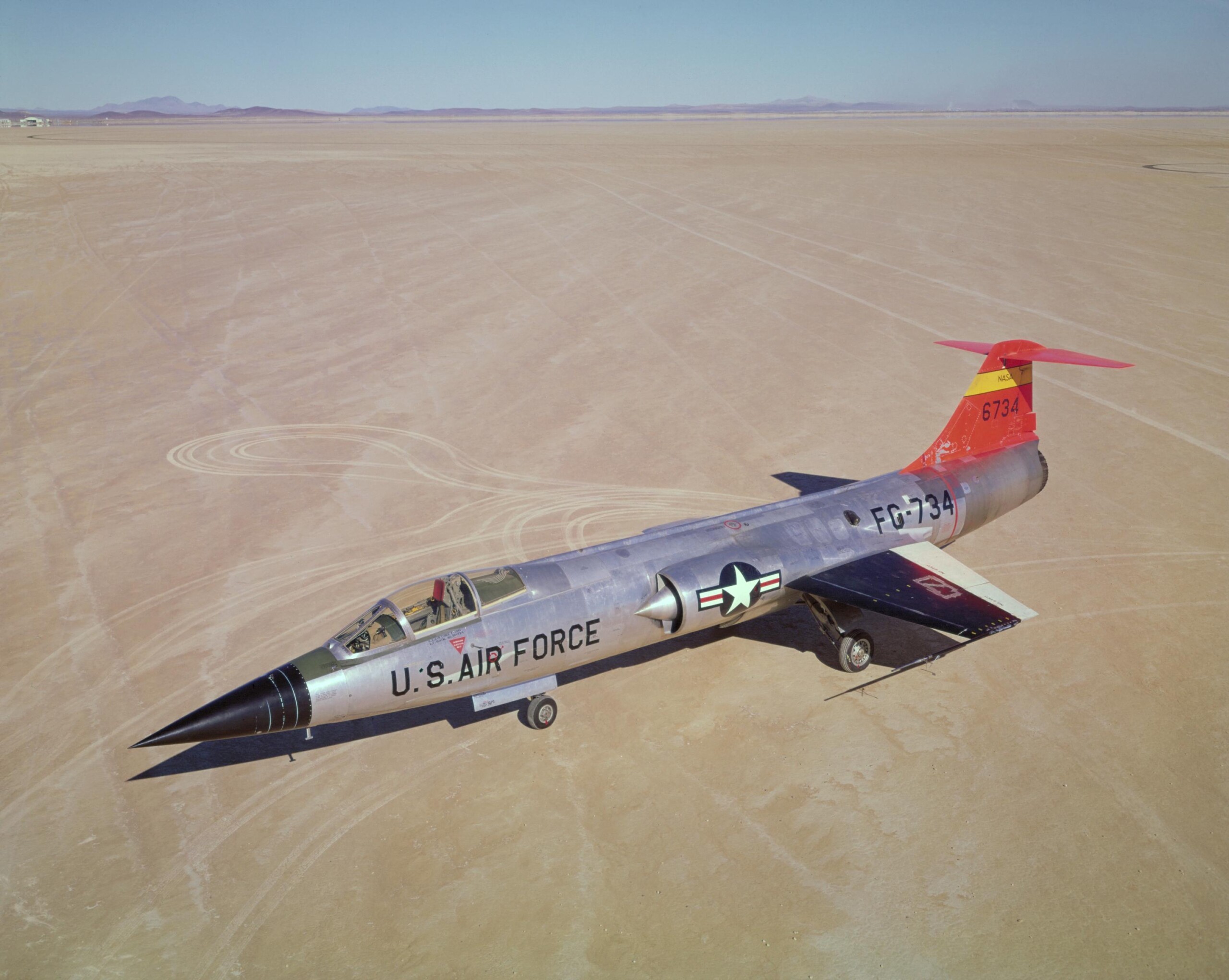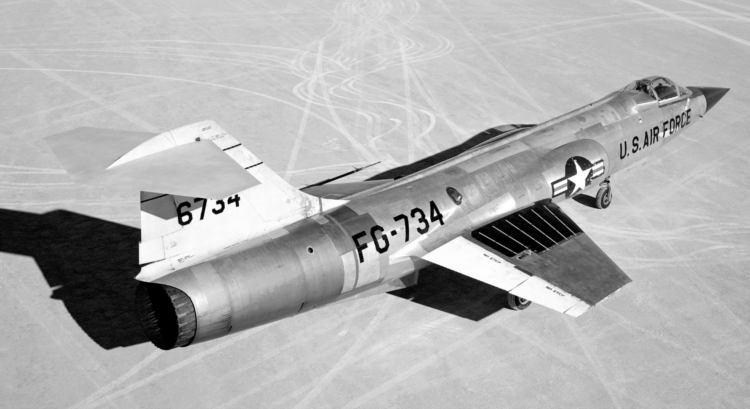Also known as the widowmaker aircraft, yikes!
In the annals of military aviation, few aircraft have garnered such infamy as the Lockheed F-104 Starfighter. Nicknamed “Flying Coffin,” this sleek and fast engineering marvel etched its name in history, but not without paying a steep price.
It was otherwise a revolutionary aircraft packed with a controversial legacy, bearing other endearing monikers such as Zipper, “the missile with a man in it,” Widowmaker, and ground nail. Yes, it may have possessed a futuristic appearance too modern for its period, but the high accident rate discouraged and made some pilots dread taking the Flying Coffin up into the skies.
The Troubled Series
We can trace back the genesis of the F-104 Starfighter to the visionary mind of Clarence “Kelly” Johnson, the genius behind Lockheed’sLockheed’s renowned secret unit Skunk Work program and with an impressive lineage that included legendary aircraft like the P-38 Lightning, the U-2 spy plane, and the SR-71 Blackbird, expectations for the F-104 soared.
The F-104 aircraft was part of the Century Series, alongside the F-101, F-102, and F-105, to amplify the US Air Force requirement for strategic nuclear warfare. Tactical Air Command attempted to adapt to this strategic mindset by emphasizing interceptors and fighters capable of delivering nuclear weapons. However, this approach led to problem after problem (a common theme that emerged throughout this aircraft series) as the jet fighter class faced challenges in their intended missions.

The F-101 Voodoo, for instance, was an interceptor converted into a fighter-bomber, resulting in a role mismatch. The F-102 Delta Dagger struggled as both an interceptor and a fighter-bomber and found its most notable service as a target drone. And yeah, you might notice that we skipped F-103, not because I forgot to add it, but because it was never built. Assigned to Republic Aviation, the phased-out F-103 was supposed to be a Mach 3 interceptor aircraft. But it was canceled in the late 1950s because it was simply too ahead of its time. It was too complicated, too expensive to build.
Then the concept of the F-104 arose, and it turned out to be a more realistic and affordable alternative to the F-103, which was also capable of reaching up to the speeds of Mach 3 (thrice the speed of sound).
The Nation’s First Mach 2 Aircraft
The single-engine, supersonic jet fighter took to the skies for the first time in early March 1954 and officially entered service four years later, with a total production of nearly 2,580 units.
It was powered by the General Electric J-79-7A turbojet, generating a formidable 15,500 pounds of thrust. The Starfighter embodied sleekness and agility, with a wingspan of 21 feet, 9 inches (6.6 meters), a length of 54 feet, 8 inches (16.7 meters), and a maximum weight of 12,634 kilograms (27,853 pounds). In addition, its design consisting of its long, thin fuselage and stubby wings is the reason why it earned the nickname “the missile with a man in it,” as it resembles a missile more than a conventional aircraft—that, and the fact that the jet fighter itself was lethal even to its own pilots.

Nevertheless, it became the first interceptor in our nation’s service that could reach a blistering top speed of Mach 2.2 (approximately twice the speed of sound) and operate at altitudes up to 58,000 feet. Armed with an M61A1 Vulcan 20mm cannon and two to four AIM-9 Sidewinder air-to-air missiles, it had a combat radius of 294 nautical miles. The F-104 was a promising jet fighter compared to the other platforms that emerged before it, but its dazzling performance came at a cost—and soon built a legacy filled with contradiction.
F-104 and its Contradicting Legacy
The F-104 Starfighter played a significant role during the Vietnam War, actively engaging from April 1965 to July 1967 and successfully completing 5,000 sorties against North Vietnamese pilots. Among its primary mission was to provide escort to Lockheed EC-130 motherships carrying drones and offer surveillance support using “Big Eye” early warning planes over North Vietnam. Additionally, the F-104 conducted strike, close-air-support, and Operation Iron Hand missions to neutralize North Vietnamese surface-to-air missile (SAM) sites. In these specific aspects of the conflicts, the Starfighter demonstrated its effectiveness and resilience.
However, the aircraft had its share of shortcomings. It suffered from limited range, outdated avionics, high landing speeds, and an unreliable engine, at least until late 1967. These factors significantly hindered its growth potential and contributed to the ominous nicknames it acquired, such as the “Flying Coffin” or the “Widowmaker.”
Unfortunately, these names held a grim truth, as the F-104 had a high number of accidents, with over 30 mishaps occurring per 100,000 flight hours. The Canadian and German air forces, in particular, experienced significant loss rates, with over 50 percent of F-104s in Canadian service and over 30 percent in German service involved in crashes.
These safety records tarnished its reputation so severely that by 1969, the US Air Force had to retire its fleet, with the Air National Guard following suit in 1975.
Nevertheless, An Iconic Fighter
Despite its troubled history, the F-104 Starfighter found redemption in foreign air forces. NATO allies such as Canada, Germany, Turkey, the Netherlands, and Italy continued to operate the aircraft. Germany, in particular, embraced the Starfighter after witnessing its potential and even managed to reduce accidents through specialized training programs. Even non-NATO nations like Japan and Pakistan included the F-104 in their fleets.
Today, surviving F-104s found themselves a home in military aviation museums worldwide, including the Smithsonian National Air and Space Museum in Washington, DC, and the Wings Over the Rockies Museum in Denver, Colorado. These relics serve as a testament to the enduring allure of this once-controversial aircraft.
The Lockheed Martin F-104 Starfighter, despite its moniker as the Flying Coffin, was nevertheless a remarkable aircraft that pushed the boundaries of speed and performance, leaving an indelible mark on military aviation history.
—
Want to know more about the Century Series Fighters that flew the US Air Force into the supersonic era? Check out “The Century Series” here to add them to your reading list today!










COMMENTS
You must become a subscriber or login to view or post comments on this article.